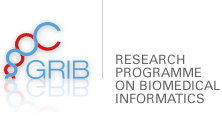
The European project @neurIST has been called to negotiation by the European Commission
The European Commission has just made official its approval to the take off of the project “@neurIST: Integrated Biomedical Informatics for the Management of Cerebral Aneurysm”, where the Research Unit on Biomedical Informatics – GRIB (IMIM/UPF) will significantly contribute with its expertise on Bioinformatics and management of the whole project.
The personal effect of aneurysm rupture is devastating: morbidity and mortality are high, affecting two thirds of afflicted patients. The aim of @neurIST is to transform the management of cerebral aneurysm by providing new insight, personalized risk assessment and methods for the design of improved medical devices and treatment protocols.
The European Union (EU) will fund the project @neurIST with around 12MM euros for a period of 4 years. @neurIST is an Integrated Project that will develop in the context of the VI Framework Programme of the EU, specifically in its priority of integrating and strengthening the European Research Area of Information Society Technologies.
@neurIST project will be carried out by a consortium integrated by 33 public organizations and private firms of thirteen different countries, basically European, but which also include several organizations from the USA, New Zealand and Japan.
Besides the participation of Universitat Pompeu Fabra (UPF) and Institut Municipal d’Investigació Mèdica (IMIM and IMIM Foundation), there are some other catalan institutions who will have a role in this project as Hospital Clínic i Provincial de Barcelona and Hospital General de Catalunya. @neurIST also includes four multinational (Philips and NEC included) and six small and medium-sized companies, among them the Majorcan enterprise GridSystems.
@neurIST will develop an IT infrastructure for the management and processing of heterogeneous data associated with the diagnosis and treatment of cerebral aneurysm and subarachnoid haemorrhage, in order to minimized its economic and societal impact in Europe. Personalized risk assessment alone could reduce unnecessary treatment by 50% or more, with concomitant savings estimated in the order of thousands million of euros per annum. Furthermore the approach will be extendable to other disease processes and scalable to federate a large number of clinical centers and public databases.


